Introduction
The U.S. Department of Labor and the State of Nevada Department of Employment, Training and Rehabilitation develop biennial projections of the aggregate economy, labor force, and industry and occupational employment. In prior projections, each occupation was assigned to 1- of-11 training or education categories based on the occupation’s most significant source of education and training. The assigned category was judged to represent the best avenue for entrance and ultimate success in the occupation.
Nevada Employment 2004-2014
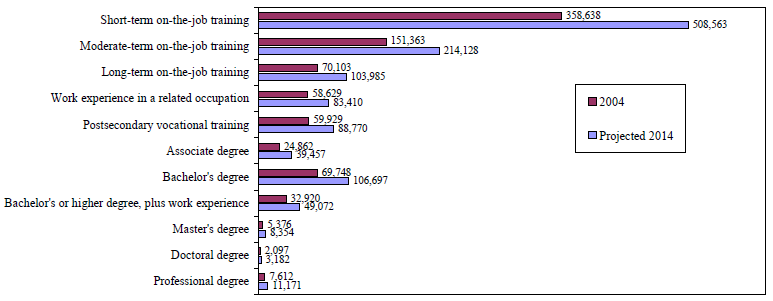
Source: Nevada Demand Occupations 2004-2014, Nevada Workforce Informer, 2007
Data From Nevada Employment
Employment
In 2006, approximately 67% of workers in Nevada were employed in occupations that generally required on-thejob training. More than 60% of this training could be achieved in less than one year (moderate or short term). 42% of these jobs required less than one month of training. Jobs requiring this level of training are expected to grow approximately 41% to 48% between 2004 and 2014. While the majority of jobs in Nevada required some form of on-the-job training, only 14% required workers to have a bachelor’s degree or higher.
An adequately trained workforce is essential for successful economic development, which benefits business, government and labor. Understanding current and future demand for skilled labor, economic development, workforce and education agencies can target resources to meet this demand for targeted occupations. This fact sheet investigates current and projected growth in occupation by education and training from a national and state of Nevada perspective.
Additionally, approximately 4% of these jobs required work experience in addition to the degree. Jobs requiring this level of training are expected to grow approximately 46% to 55% between 2004 and 2014.
Nationally in 2006, approximately 63 percent of workers were employed in occupations that generally required onthe- job training. More than 55% of this training could be achieved in less than one year (moderate or short term). Thirty-five percent of these jobs required less than one month of training. Jobs requiring this level of training are expected to grow approximately 8% to 11% between 2004 and 2014. While the majority of jobs in the United States required some form of on-the-job training, only 20% of jobs required workers to have a bachelor’s degree or higher. Additionally, approximately 4% of these jobs required work experience in addition to the degree. Jobs requiring this level of training are expected to grow approximately 16% to 31% between 2004 and 2014.
United States Employment 2004-2014
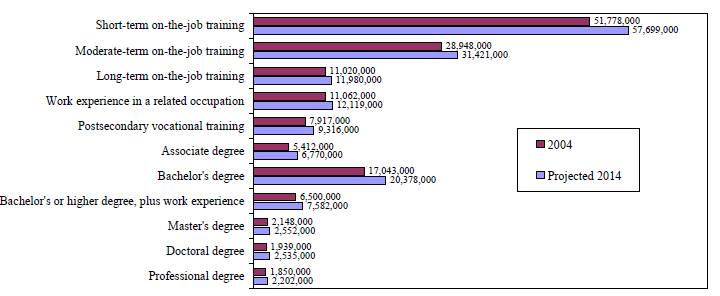
Source: Occupational Projections and Training Data 2004-2005 edition, US Bureau of Labor Statistics
Data From United States Employment
Job Growth
Between 2004 and 2014, Nevada’s job growth rate (42.7%) is expected to outpace the national job growth rate (13.0%). In Nevada, jobs requiring associate degrees are predicted to grow the fastest. Jobs requiring moderate-term on-the-job training are expected to grow the slowest. Nationally, jobs requiring a doctoral degree are expected to grow the fastest. Jobs requiring moderate-term on-the-job training are forecasted to grow the slowest.
Job Growth Rate 2004-2014
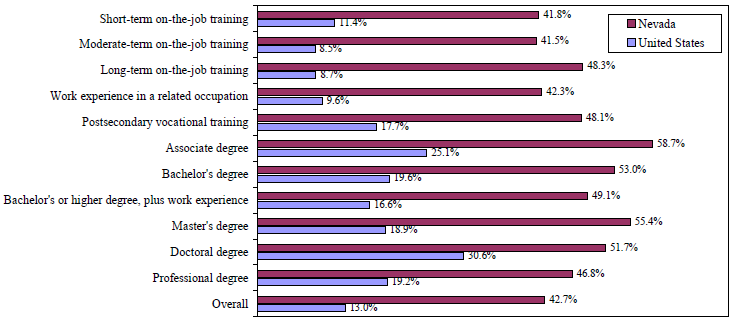
Source: Nevada Demand Occupations 2004-2014, Nevada Workforce Informer, 2007; Occupational Projections and Training Data 2004-2005 edition, US Bureau of Labor Statistics
Data From Job Growth Rate
Job Openings
Between 2004 and 2014, Nevada’s economy is predicted to have nearly 600,000 job openings because of growth or replacements. The majority (64%) of these openings will be due to growth. Of these total openings, more than 400,000 will require some on-the-job training with most openings needing less than a month of training. It is interesting to note that while almost half of all job openings will require short-term on-the-job training, this class of jobs has the lowest percentage of growth openings with just 55% of total openings due to growth.
In contrast, openings requiring a professional degree account for less than 1% of total openings, but these jobs have the highest percentage of growth openings relative to total openings, at 76%.
Nevada Job Openings 2004-2014
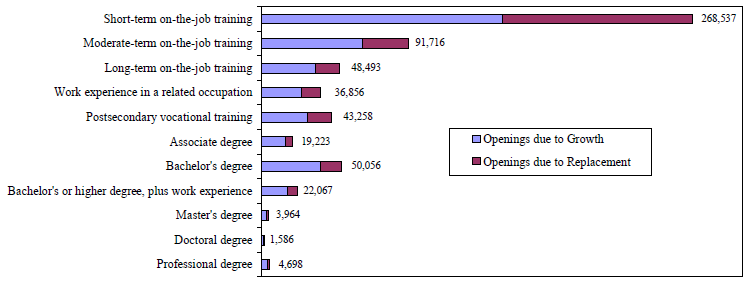
Source: Nevada Demand Occupations 2004-2014, Nevada Workforce Informer, 2007
Data From Nevada Job Openings
Between 2004 and 2014, the U.S. economy is predicted to have more than 53.2 million job openings because of growth or replacements. In contrast to Nevada, the majority (64%) of these openings will be due to replacement. Of these total openings, more than 33 million will require some on-the-job training with most openings needing less than a month of training. It is interesting to note that while almost half of all job openings will require short-term on-the-job training, this class of jobs has the lowest percentage of growth openings with just 27% of total openings due to growth. In contrast, openings requiring a doctoral degree account for less than 2% of total openings, but these jobs have the highest percentage of growth openings relative to total openings at 58%.
United States Job Openings 2004-2014
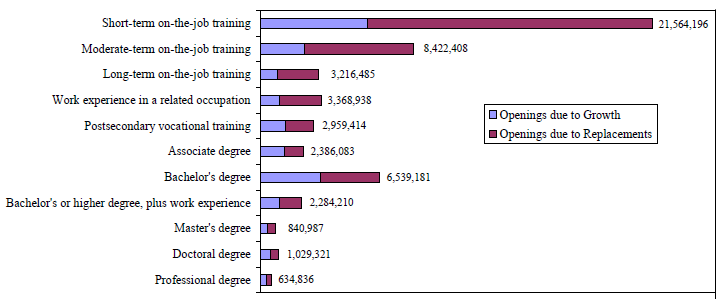
Source: Occupational Projections and Training Data 2004-2005 edition, US Bureau of Labor Statistics
Data From United States Job Openings
Wages
Generally, jobs requiring higher levels of education and experience tend to pay higher entry-level and median wages. Nationally, jobs requiring a professional or doctoral degree pay the highest wages, while jobs needing only moderate or short-term training pay the lowest entrylevel and median wages. In Nevada, wages for jobs requiring only moderate or short-term training follow the same trend as the United States. However, the pay for jobs needing moderate training was higher in Nevada than the United States. Surprisingly, occupations requiring a doctoral degree in Nevada have lower entry-level and median wages than occupations requiring much lower levels of education.
2006 Annual Entry Level Wages
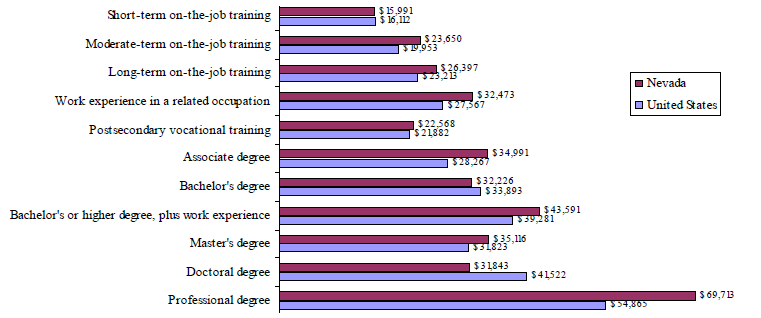
Source: Occupational Employment and Wage Estimates for Nevada and the United States, US Bureau of Labor Statistics, May 2006
Data From Annual Entry Level Wages
In general, occupations requiring advanced training or education have higher earning potential as workers move from entry-level work to more experienced work. In the United States, occupations requiring a bachelor’s degree or higher led to wage gains of more than $20,000. In Nevada, occupations with the potential for wage gains of $20,000 or more require a professional degree, bachelor’s degree, or an advanced degree with work experience. Both nationally and in Nevada, only jobs requiring short-term training led to wage gains of less than $10,000. Also, for the state of Nevada and the United States, jobs that require college training are among the highest paid and fastest growing.
2006 Annual Median Wages
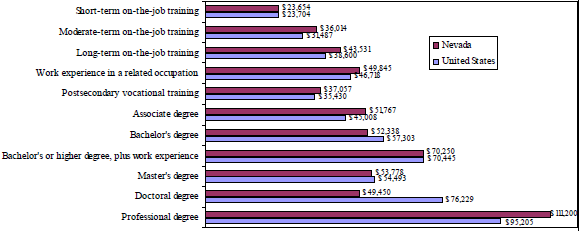
Source: Occupational Employment and Wage Estimates for Nevada and the United States, US Bureau of Labor Statistics, May 2006
Data From Annual Median Wages
Conclusion
A well-trained workforce is necessary for economic growth. Policymakers can use this information to ensure that future workers have the necessary skills and training to meet the demand for targeted occupations.
Nevada Employment 2004-2014
| Category |
2004 |
Projected 2014 |
| Short-term on-the-job training |
358,638 |
508,563 |
| Moderate-term on-the-job training |
151,363 |
214,128 |
| Long-term on-the-job training |
70,103 |
103,985 |
| Work experience in a related occupation |
58,629 |
83,410 |
| Postsecondary vocational training |
59,929 |
88,770 |
| Associate degree |
24,862 |
39,457 |
| Bachelor's degree |
69,748 |
106,697 |
| Bachelor's or higher degree, plus work experience |
32,920 |
49,072 |
| Master's degree |
5,376 |
8,354 |
| Doctoral degree |
2,097 |
3,182 |
| Professional degree |
7,612 |
11,171 |
United States Employment 2004-2014
| Category |
2004 |
Projected 2014 |
| Short-term on-the-job training |
51,778,000 |
57,699,000 |
| Moderate-term on-the-job training |
28,948,000 |
31,421,000 |
| Long-term on-the-job training |
11,020,000 |
11,980,000 |
| Work experience in a related occupation |
11,062,000 |
12,119,000 |
| Postsecondary vocational training |
7,917,000 |
9,316,000 |
| Associate degree |
5,412,000 |
6,770,000 |
| Bachelor's degree |
17,043,000 |
20,378,000 |
| Bachelor's or higher degree, plus work experience |
6,500,000 |
7,582,000 |
| Master's degree |
2,148,000 |
2,552,000 |
| Doctoral degree |
1,939,000 |
2,535,000 |
| Professional degree |
1,850,000 |
2,202,000 |
Job Growth Rate 2004-2014
| Category |
Nevada |
United States |
| Short-term on-the-job training |
41.8% |
11.4% |
| Moderate-term on-the-job training |
41.5% |
8.5% |
| Long-term on-the-job training |
48.3% |
8.7% |
| Work experience in a related occupation |
42.3% |
9.6% |
| Postsecondary vocational training |
48.1% |
17.7% |
| Associate degree |
58.7% |
25.1% |
| Bachelor's degree |
53.0% |
19.6% |
| Bachelor's or higher degree, plus work experience |
49.1% |
16.6% |
| Master's degree |
55.4% |
18.9% |
| Doctoral degree |
51.7% |
30.6% |
| Professional degree |
46.8% |
19.2% |
| Overall |
42.7% |
13.0% |
Nevada Job Openings 2004-2014
| Category |
Openings due to Growth and Replacement |
| Short-term on-the-job training |
268,537 |
| Moderate-term on-the-job training |
91,716 |
| Long-term on-the-job training |
48,493 |
| Work experience in a related occupation |
36,856 |
| Postsecondary vocational training |
43,258 |
| Associate degree |
19,223 |
| Bachelor's degree |
50,056 |
| Bachelor's or higher degree, plus work experience |
22,067 |
| Master's degree |
3,964 |
| Doctoral degree |
1,586 |
| Professional degree |
4,698 |
United States Job Openings 2004-2014
| Category |
Openings due to Growth and Replacement |
| Short-term on-the-job training |
21,564,196 |
| Moderate-term on-the-job training |
8,422,408 |
| Long-term on-the-job training |
3,216,485 |
| Work experience in a related occupation |
3,368,938 |
| Postsecondary vocational training |
2,959,414 |
| Associate degree |
2,386,083 |
| Bachelor's degree |
6,539,181 |
| Bachelor's or higher degree, plus work experience |
2,284,210 |
| Master's degree |
840,987 |
| Doctoral degree |
1,029,321 |
| Professional degree |
634,836 |
2006 Annual Entry Level Wages
| Category |
Nevada |
United States |
| Short-term on-the-job training |
$15, 991 |
$16, 112 |
| Moderate-term on-the-job training |
$23, 650 |
$19, 953 |
| Long-term on-the-job training |
$26, 397 |
$23, 213 |
| Work experience in a related occupation |
$32, 473 |
$27, 567 |
| Postsecondary vocational training |
$22, 568 |
$21, 882 |
| Associate degree |
$34, 991 |
$28, 267 |
| Bachelor's degree |
$32, 226 |
$33, 893 |
| Bachelor's or higher degree, plus work experience |
$43, 591 |
$39, 281 |
| Master's degree |
$35, 116 |
$31, 823 |
| Doctoral degree |
$31, 843 |
$41, 522 |
| Professional degree |
$69, 713 |
$54, 865 |
2006 Annual Median Wages
| Category |
Nevada |
United States |
| Short-term on-the-job training |
$23, 654 |
$23, 704 |
| Moderate-term on-the-job training |
$36, 014 |
$31, 487 |
| Long-term on-the-job training |
$43, 531 |
$38 ,600 |
| Work experience in a related occupation |
$49, 845 |
$46, 718 |
| Postsecondary vocational training |
$37, 057 |
$35, 430 |
| Associate degree |
$51, 767 |
$45, 008 |
| Bachelor's degree |
$52, 338 |
$57, 303 |
| Bachelor's or higher degree, plus work experience |
$70, 250 |
$70, 445 |
| Master's degree |
$53, 778 |
$54, 493 |
| Doctoral degree |
$49, 450 |
$76, 229 |
| Professional degree |
$111, 200 |
$95, 205 |


